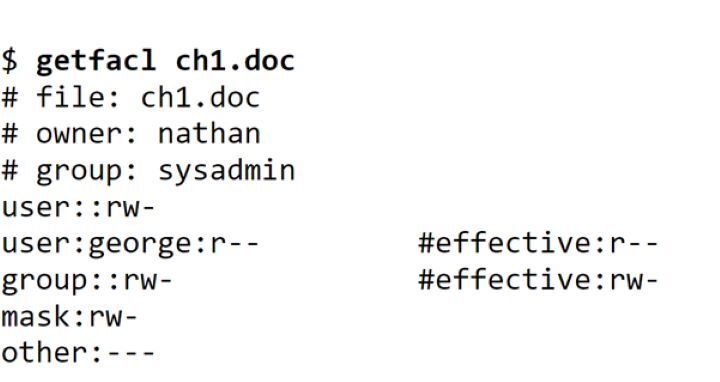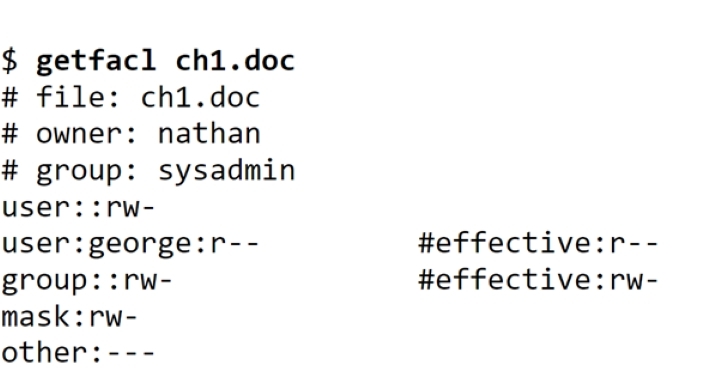
 Data Structure
Data Structure Networking
Networking RDBMS
RDBMS Operating System
Operating System Java
Java MS Excel
MS Excel iOS
iOS HTML
HTML CSS
CSS Android
Android Python
Python C Programming
C Programming C++
C++ C#
C# MongoDB
MongoDB MySQL
MySQL Javascript
Javascript PHP
PHP
- Selected Reading
- UPSC IAS Exams Notes
- Developer's Best Practices
- Questions and Answers
- Effective Resume Writing
- HR Interview Questions
- Computer Glossary
- Who is Who
Secure Files/Directories using ACLs (Access Control Lists) in Linux
ACLs (Access Control Lists) in Linux give an adaptable and granular way to secure records and catalogues. With ACLs, authorizations can be set for individuals, clients, and bunches beyond the conventional proprietor, bunch, and others. This permits fine-grained control over access rights. By utilising commands like "setfacl" and "getfacl," chairmen can characterise particular consents, such as perused, typed in, and executed, for numerous clients or bunches at the same time. ACLs upgrade security by empowering chairmen to confine or allow access to particular assets, guaranteeing that, as it were, authorised people or bunches can connect with touchy records and registries.
Methods Used
Setting default ACLs
Granting specific permissions
Setting Default ACLs
Setting default ACLs in Linux includes characterising consents that are naturally connected to recently made records and catalogues inside a particular catalogue. By indicating default ACLs, chairmen can guarantee steady access rights for all future things made in that registry. This approach eliminates the need to physically relegate authorizations to each modern record or registry independently. It upgrades security by upholding foreordained access controls, making it simpler to preserve a standardised and secure environment. Default ACLs streamline the method of overseeing authorizations, guaranteeing that fitting get-to rights are consequently allowed to recently made assets, sparing time and exertion for directors.
Algorithm
Begin the calculation by selecting the target catalogue where you need to set default ACLs.
Identify the required default consents for recently made records and registries inside the target registry. Decide the particular get-to rights, such as studied, typed in, and executed, that ought to be allowed by default.
Use the fitting command (e.g., setfacl) to set the default ACLs on the target catalogue. The command may incorporate alternatives to indicate the default authorizations, such as the proprietor, gather, and other clients or bunches to which the consents ought to apply.
Verify that the default ACLs have been effectively set by employing a command like getfacl to see the ACLs for the target directory. Guarantee that the default authorizations adjust with the specified get-to controls.
Test the default ACLs by making modern records and registries inside the target directory. Affirm that the recently made things acquire the default consents as indicated within the ACLs.
Periodically survey and upgrade the default ACLs as required. As the security prerequisites or get-to arrangements alter, alter the default ACLs appropriately to preserve a suitable level of get-to control.
Output

Granting Specific Permissions
Allowing particular consents alludes to the capacity to dole out exact access rights to individual clients or groups utilising ACLs in Linux. Within the setting of default ACLs, chairmen can characterise particular authorizations that will be consequently connected to all recently made records and registries inside an assigned catalogue. This guarantees reliable control for future things. By indicating perused, composed, and executed authorizations for diverse clients or bunches, chairmen can tailor the access rights to coordinate the required security prerequisites. This approach streamlines the method of allowing authorizations, sparing time and exertion while guaranteeing that fitting get-to levels are reliably implemented.
Algorithm
Start by distinguishing the catalogue where you need to set default ACLs.
Determine the particular authorizations you want to give, such as examined, typed in, or executed, and distinguish the clients or groups to whom these authorizations will be assigned.
Use a suitable command, such as "setfacl," to set default ACLs for the target catalogue. This command permits you to indicate the authorizations and the related clients or groups.
Validate the connected default ACLs by utilising the "getfacl" command to show the ACL entries for the registry. Affirm that the required consents and user/group assignments are precisely reflected.
Test the default ACLs by making a modern record or catalogue inside the assigned registry. Confirm that the consents doled out to the recently made thing align with the default ACL settings.
Periodically survey and review the default ACLs to guarantee they meet the security prerequisites. Make vital alterations, such as including or evacuating clients or groups, altering authorizations, or overhauling the default ACLs as required
Output

Conclusion
This article clarifies how to secure records and registries in Linux using ACLs (Get to Control Records). It talks about the strategies of setting default ACLs and giving particular consents to control access rights. The article gives calculations for each strategy, specifying the steps included in actualizing and overseeing ACLs. By leveraging ACLs, chairmen can implement fine-grained access control, dole out consents to individual clients or bunches, and guarantee that, as it were, authorised people can connect with delicate records and catalogues. Generally, the article points to engaging Linux chairmen with the information to improve security through successful ACL execution.

